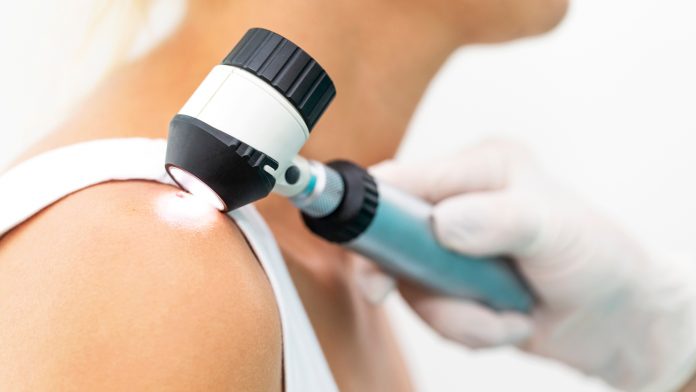
A new survey indicated that 1.71% of the adult European general population reported a skin cancer diagnosis.
The European Academy of Dermatology and Venereology (EADV) survey revealed overwhelming data about skin cancer diagnosis prevalence in Europe. The data from the survey found that 7,304,000 Europeans are estimated to have the disease.
The survey data also show that a mole check or skin cancer diagnosis screening was the main reason for patients consulting a dermatologist over the past 12 months, with over a fifth (22.3%) of appointments made with a skin specialist being to check a mole or lesion.
The growing burden of skin cancer diagnosis
The EADV’s Burden of Skin Disease (BOSD) survey collected data from 44,689 adults from 27 countries; the data illuminates the need for an “expansion in skin cancer education across Europe to help the population make safer skin choices,” according to leading dermatologists at the organisation.
0.6% of the participants reported a skin cancer diagnosis of melanoma. However, the most widespread and rapidly increasing cancer is keratinocyte carcinomas, which include basal cell and squamous cell carcinomas.
Marie-Aleth Richard, Professor at the University Hospital of La Timone, Marseilles and the EADV Board Member leading the survey, said the results “demonstrate the need for action to be taken to prevent skin cancer, which has a good prognosis if caught early but is perceived by the population as a serious and life-threatening condition.”
Professor Richard said she believed the survey “underscores the need for improved understanding, education and awareness about skin cancer and implementing evidence-based interventions as part of Europe’s Beating Cancer Plan.”
“Skin cancer is part of the 40% of cancers that are preventable and whose incidence we could considerably reduce if we provided more consistent and widespread education to the population,” she added.
“This should be complementary to an adequate policy and regulatory framework to reduce the incidence of skin cancer and prevent it becoming a significant challenge to health systems.”
Quality of life
46.6% of participants who reported at least one skin cancer diagnosis said they felt ‘moderately or extremely anxious and depressed’, with anxiety and fear about surgical scars, death and metastasis being the main reason for an alteration in the quality of life.
Nearly half of the participants stated there was a negative impact on their personal life, and almost three in five said they were impacted in their professional life. The biggest result was a change in working hours or altering professional activity, but 22.6% said they did not get a hoped-for job and 31.3% refused a professional offer.
Skin cancer professionals: Dermatologists
52.73% of the survey participants recognised Dermatologists as skin cancer diagnosis experts and trusted them to treat their condition over a general practitioner or other healthcare professional.
The type of doctor consulted in the case of skin cancer varied by country, with the largest percentage of patients who called on a dermatologist in the first instance found in Italy (53%), France (47.4%) and Spain (44.8%).
The lowest proportion reported was in the UK, where only 11.9% of patients initially went to a dermatologist, followed by Poland with 13.5%. However, in almost half of the cases (45.7%), the final diagnosis was predominantly made by a dermatologist.
“As recognised experts for the management of skin cancers, dermatologists must play a central role in public health strategies for beating cancer and in educating the general public, media, stakeholders and decision-makers about skin diseases including cancer,” says Professor Alexander Stratigos, President of the EADV.
“These include promoting the protection of children and teenagers to reduce the risk of skin cancers developing in later life, implementing UV protection measures for outdoor workers and the regulation of sunbeds as medical devices, not consumer products,” he added.







